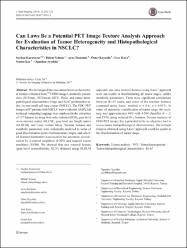Can Laws Be a Potential PET Image Texture Analysis Approach for Evaluation of Tumor Heterogeneity and Histopathological Characteristics in NSCLC?

Göster/
Erişim
info:eu-repo/semantics/openAccessTarih
2018Yazar
Karacavus, SeyhanYılmaz, Bülent
Tasdemir, Arzu
Kayaaltı, Ömer
Kaya, Eser
İçer, Semra
Ayyıldız, Oguzhan
Üst veri
Tüm öğe kaydını gösterKünye
JOURNAL OF DIGITAL IMAGING Volume: 31 Issue: 2 Pages: 210-223 DOI: 10.1007/s10278-017-9992-3Özet
We investigated the association between the textural features obtained from F-18-FDG images, metabolic parameters (SUVmax(,) SUVmean, MTV, TLG), and tumor histopathological characteristics (stage and Ki-67 proliferation index) in non-small cell lung cancer (NSCLC). The FDG-PET images of 67 patients with NSCLC were evaluated. MATLAB technical computing language was employed in the extraction of 137 features by using first order statistics (FOS), gray-level co-occurrence matrix (GLCM), gray-level run length matrix (GLRLM), and Laws' texture filters. Textural features and metabolic parameters were statistically analyzed in terms of good discrimination power between tumor stages, and selected features/parameters were used in the automatic classification by k-nearest neighbors (k-NN) and support vector machines (SVM). We showed that one textural feature (gray-level nonuniformity, GLN) obtained using GLRLM approach and nine textural features using Laws' approach were successful in discriminating all tumor stages, unlike metabolic parameters. There were significant correlations between Ki-67 index and some of the textural features computed using Laws' method (r = 0.6, p = 0.013). In terms of automatic classification of tumor stage, the accuracy was approximately 84% with k-NN classifier (k = 3) and SVM, using selected five features. Texture analysis of FDG-PET images has a potential to be an objective tool to assess tumor histopathological characteristics. The textural features obtained using Laws' approach could be useful in the discrimination of tumor stage.

















